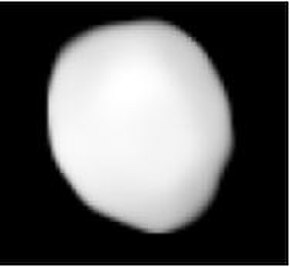Loading AI tools
Large asteroid in the asteroid belt From Wikipedia, the free encyclopedia
52 Europa is the sixth largest asteroid in the asteroid belt, having a diameter of over 300 km, though it is not correspondingly massive. It is not round but is shaped like an ellipsoid of approximately 380×330×250 km.[4] It was discovered on 4 February 1858, by Hermann Goldschmidt from his balcony in Paris. It is named after Europa, one of Zeus's conquests in Greek mythology, a name it shares with Jupiter's moon Europa.
 | |
| Discovery | |
|---|---|
| Discovered by | H. Goldschmidt |
| Discovery date | 4 February 1858 |
| Designations | |
| (52) Europa | |
| Pronunciation | /jʊˈroʊpə/[1] |
Named after | Europa |
| 1948 LA | |
| Main belt | |
| Adjectives | Europan, Europian |
| Orbital characteristics[2] | |
| Epoch July 01, 2021 (JD 2459396.5, heliocentric) | |
| Aphelion | 3.444 AU (510 Gm) |
| Perihelion | 2.75 AU (420 Gm) |
| 3.095 AU (460 Gm) | |
| Eccentricity | 0.111 |
| 5.45 yr (1989 d) | |
| 21° | |
| Inclination | 7.48° |
| 129° | |
| 343° | |
| Physical characteristics | |
| Dimensions | c/a = 0.67±0.04[3] (379±16)×(330±8)×(249±10) km[4] |
| 319±4 km[3] 315±7 km[4] | |
| Mass | (24±4)×1018 kg[3] (22.6±1.6)×1018 kg[lower-alpha 1][5] |
Mean density | 1.41±0.23 g/cm3[3] 1.5±0.4 g/cm3[4] |
| 5.63 h[2] | |
| 0.057±0.007 geometric (0.679±0.017 BV, 0.338±0.028 UB)[2] | |
| Temperature | ~173 K max: 258K (−15 °C)[6] |
| C/CF[2] | |
| 6.48[2] | |

Europa is approximately the sixth largest asteroid by volume. Most likely it has a density of around 1.5 g/cm3, typical of C-type asteroids.[4] In 2007, James Baer and Steven R. Chesley estimated Europa to have a mass of (1.9±0.4)×1019 kg.[7] A more recent estimate by Baer suggests it has a mass of 3.27×1019 kg.[8]
Europa is a very dark carbonaceous C-type, and is the second largest of this group. Spectroscopic studies have found evidence of olivines and pyroxenes on the surface,[9] and there is some indication that there may be compositional differences between different regions.[10] It orbits close to the Hygiea asteroid family, but is not a member.
Lightcurve data for Europa have been particularly tricky to interpret, so much so that for a long time its period of rotation was in dispute (ranging from 5+1⁄2 hours to 11 hours), despite numerous observations.[11] It has now been determined that Europa is a prograde rotator, but the exact direction in which its pole points remains ambiguous. The most detailed analysis indicates that it points either towards about ecliptic coordinates (β, λ) = (70°, 55°) or (40°, 255°) with a 10° uncertainty.[12] This gives an axial tilt of about 14° or 54°, respectively.
In 1988 a search for satellites or dust orbiting this asteroid was performed using the UH88 telescope at the Mauna Kea Observatories, but the effort came up empty.[13]
It has been found that the reputed cataclysmic variable star CV Aquarii, discovered in 1934, was actually a misidentification of 52 Europa.[14]

Seamless Wikipedia browsing. On steroids.
Every time you click a link to Wikipedia, Wiktionary or Wikiquote in your browser's search results, it will show the modern Wikiwand interface.
Wikiwand extension is a five stars, simple, with minimum permission required to keep your browsing private, safe and transparent.